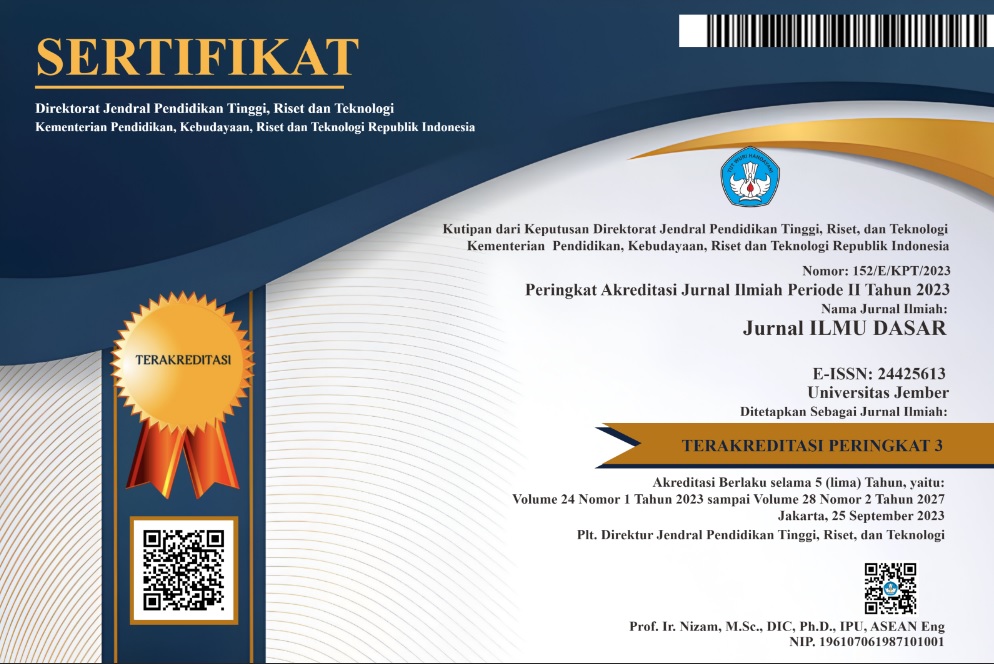Microcellulose from Betel Husk Fiber as Filler in Bioplastic
Microsellulose from Betel Nut Husk Fiber As Filler in Bioplastic
DOI:
https://doi.org/10.19184/jid.v24i1.34023Keywords:
Betel nut husk fiber, Bioplastic, Cellulose, Delignification, MicrocelluloseAbstract
Betel nut husk fiber has a reasonably high cellulose content. Meanwhile, bioplastics nowadays are mostly made of Poly Vinyl Alcohol (PVA), with one of its limitations being tensile strength and other properties regarding mechanical. Thus, this study aims to isolate microcellulose from areca nut fiber and use the fiber as a filler in bioplastic, where cellulose is combined with PVA. The intention is to understand the effect of adding microcellulose from betel nut fibers on the properties, including the biodegradability of PVA-based bioplastic films. This research has three steps: isolating cellulose from betel nut peel fibers by delignification, pulping, and bleaching. The next step is hydrolysis to obtain microcellulose. The last is the preparation of bioplastic films using the solution casting method, with five different ratios of microcellulose content in the bioplastic. The cellulose characterization from FTIR spectra shows the absorption of several peaks, such as O-H, C-H, and C-O functional groups. The mechanical testing results on the variation of bioplastic show that the bioplastic with the best characteristics was PL5, which has the highest microcellulose content, 8 MPa and 10.2% for tensile strength and elongation, respectively. The biodegradation test for bioplastic variation (PL5) was 82% within eight weeks, while in Indonesian National Standard (SNI) number 7188.7:2016, it is 100% within 60 days.
Downloads
References
Atmaka W & Lestariana S. 2017. Studi Karakteristik Pati Singkong Utuh Berbasis Edible Film Dengan Modifikasi Cross-Linking Asam Sitrat. Jurnal Teknologi Pertanian. 18(2): 143-152.
Dynanty SDP & Mahyudin A. 2018. Pengaruh Panjang Serat Pinang Terhadap Sifat Mekanik dan Uji Biodegradasi Material Komposit Matriks Epoksi dengan Penambahan Pati Talas. Jurnal Fisika Unand. 7(3): 233-239.
Flury M & Narayan R. 2021. Biodegradable Plastic as An Integral Part of The Solution to Plastic Waste Pollution of The Environment. Current Opinion in Green and Sustainable Chemistry. 30(100490): 1-7.
Hahladakis JN, Velis CA, Weber R, Iacovidou E & Purnell P. 2018. An Overview of Chemical Additives Present in Plastics: Migration, Release, Fate And Environmental Impact During Their Use, Disposal and Recycling. Journal of
Hazardous Materials. 344: 177-199.
Haque ANMA & Naebe M. 2021. Flexible Water-Resistant Semi-Transparent Cotton Gin Trash/Poly (Vinyl Alcohol) Bio-Plastic for Packaging Application: Effect of Plasticisers on Physicochemical Properties. Journal of Cleaner Production. 303: 126983.
Hu C, Battampara P, Guna V & Reddy N. 2021. Effect of Alkali Treatment on the Structure and Properties of Natural Cellulose Fibers from Areca Cathechu Shells. Journal of Natural Fibers. 19(14): 9754-9764.
Huntley CJ, Crews KD, Abdalla MA, Russell AE & Curry ML. 2015. Influence of Strong Acid Hydrolysis Processing on The Thermal Stability and Crystallinity of Cellulose Isolated From Wheat Straw. International Journal of Chemical Engineering. 2015: 658163.
Jufrinaldi. 2018. Isolasi Selulosa Dari Bagas Tebu Melalui Pemanasan Iradiasi Gelombang Mikro. Jurnal Ilmiah Teknik Kimia. 2(2): 36-46.
Kencanawati CPK, Sugita IKG, Suardana N & Suyasa IWB. 2018. Pengaruh Perlakukan Alkali terhadap Sifat Fisik, dan Mekanik Serat Kulit Buah Pinang. Jurnal Energi Dan Manufaktur. 11(1): 6-10.
Khairunnisah. 2019. Karakterisasi Bionanokomposit Pati Sukun/PVA yang Diinkorporasi dengan Nanoserat Selulosa dan Aloe Vera [Tesis]. Universitas Sumatera Utara .
Lismeri L, Darni Y, Sanjaya MD & Immadudin MI. 2019. Pengaruh Suhu Dan Waktu Pretreatment Alkali Pada Isolasi Selulosa Limbah Batang Pisang. Journal of Chemical Process Engineering. 4(1): 18-22.
Nugroho FG, Nizardo NM & Saepudin E. 2020. Synthesis of Citric Acid Crosslinked PVA/Tapioca Starch Bioplastic Reinforced With Grafted Cellulose. AIP Conference Proceedings. 2242: 040040.
Panjaitan R. Marthin, Irdoni & Bahruddin. 2017. Pengaruh Kadar dan Ukuran Selulosa Berbasis Batang Pisang Terhadap Sifat dan Morfologi Bioplastik Berbahan Pati Umbi Talas. Universitas Riau. 4(1): 1-7.
Pratiwi P, Fahmi H & Saputra F. 2017. Pengaruh Orientasi Serat Terhadap Redaman Suara Komposit Berpenguat Serat Pinang. Simetris : Jurnal Teknik Mesin, Elektro dan Ilmu Komputer. 8(2): 813-818.
Rujnić-Sokele M & Pilipović A. 2017. Challenges and Opportunities of Biodegradable Plastics: A Mini Review. Waste Management and Research. 35(2): 132-140.
Setiani W, Sudiarti T & Rahmidar L. 2013. Preparasi Dan Karakterisasi Edible Film Dari Poliblend Pati Sukun-Kitosan. Jurnal Kimia Valensi. 3(2): 100-109.
Simarmata EO, Hartiati A & Harsojuwono BA. 2020. Karakteristik Komposit Bioplastik Dalam Variasi Rasio Pati Umbi Talas (Xanthosoma sagittifolium)-Kitosan. Jurnal Ilmiah Teknologi Pertanian Agrotechno. 5(2): 75-80.
Tamiogy WR, Kardisa A, Hisbullah H & Aprilia S. 2019. Pemanfaatan Selulosa dari Limbah Kulit Buah Pinang Sebagai Bahan Baku Pembuatan Bioplastik. Jurnal Rekayasa Kimia & Lingkungan. 14(1): 63-71.
Thakur VK, Thakur MK, Raghavan P & Kessler MR. 2014. Progress in Green Polymer Composites from Lignin for Multifunctional Applications: A Review. ACS Sustainable Chemistry and Engineering. 2(5): 1072-1092.
Wang Q, Xiao S, Shi SQ & Cai L. 2018. The Effect of Delignification on The Properties of Cellulosic Fiber Material. Holzforschung. 72(6): 443-449.








